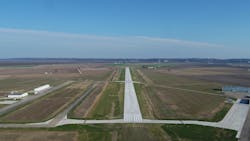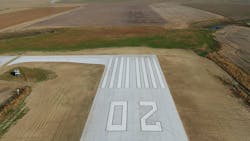Boosting Efficiency at General Aviation Airports: Thinner Pavements, Bigger Savings
Five Things You'll Learn in this Article
- Thin concrete pavements (less than 9 inches) are increasingly used at general aviation airports, providing cost savings and durability benefits.
- Concrete overlays on existing asphalt runways have demonstrated long-term performance, often exceeding their design life with minimal maintenance.
- Competitive bidding and market pressures help reduce costs, especially when using alternative pavement strategies during procurement.
- Concrete offers superior resilience to flooding, deformation, and fuel spills compared to asphalt, making it ideal for airport environments.
- Ongoing research aims to refine design standards for thin pavements and assess their flood resilience, supporting wider adoption in the future.

Concrete offers strength and durability for airport pavements, and design standards have been developed to optimize these benefits by engineering for the loading associated with commercial airports. Because aircraft have fewer tires and more concentrated point loads than highway vehicles, standards and federal specifications for large hub commercial airports are quite robust, with pavements able to withstand loading of up to 60,000 pounds per aircraft tire.
Air traffic at general aviation airports, however, is typically lighter than 60,000 pounds and does not require the pavement thicknesses specified for commercial airports. Evidence is mounting that significant cost savings and operational benefits can be achieved when general aviation airports use thinner concrete pavements. “Thin" pavements are those using less than 9 inches of concrete, with many installations ranging from just 5 to 6 inches thick.
Most thin concrete pavements installed to date at general aviation airports have been concrete resurfacing of existing asphalt, or concrete overlay.
“Early in my career, we started looking at concrete overlays as opposed to asphalt ones, because we found doing so created a little more competition in the market for us—I like to say it made the asphalt vendors sharpen their pencils,” said Anthony Cochran, Regional Engineer, Airports Division, FAA Southern Regional Office. “We've had some successful projects here in the southeast because of that.
“Our experience in South Carolina is that competitive bidding between asphalt and concrete contractors vying to win airport projects tends to drive down costs. The enhanced competition forces contractors to refine their bids to secure the work and even reaches down to the material-supplier level, because suppliers of asphalt and concrete face pressure to offer competitive pricing and keep their materials attractive for use. Using alternate bid strategies allows decision-makers to choose the pavement type during procurement, allowing real-time market pricing for materials to play a role in the selection, and when used during procurement, life cycle cost analysis increases the likelihood of selecting the most cost-effective option for any given project,” said Andy D. Busbee, Aviation Unit Manager at Michael Baker International.
“Airports, with their more specialized requirements and tighter construction windows, often struggle to attract the same number of bidders as road projects. In fact, we have had numerous projects with only one or two bidders, which can compound cost challenges,” said Gary W. Siegfried, Executive Director of the South Carolina Aeronautics Commission,
Construction inflation is reducing the dollars available for capital projects, despite agencies’ diligence in maximizing value and maintaining safety and operational standards.
“It’s a complex issue without a single cause, but the ripple effects of regional market dynamics—such as labor availability, material costs, and competitive pressure—are being felt across the aviation sector,” said Siegfried.
“The sharp rise in asphalt (P-401) prices on airport capital projects has been particularly significant,” continued Siegfried. “Since 2022, the cost of P-401 has nearly doubled, rising from an average of $152 per ton to $283 per ton in 2025. This escalation has significantly reduced the purchasing power of available funding for airfield infrastructure projects. The increase in asphalt price has been experienced on a regional basis but—possibly because of broad market demand including a substantial number of road and bridge projects in the state—it is being felt strongly in South Carolina.”
“There are far reaching impacts for competitive bidding,” said Busbee. “It fosters a healthy marketplace where both concrete and asphalt industries can invest in skilled personnel, improve their supply chains, enhance construction quality, encourage innovation, and reduce project risks. I can cite many examples, with the most recent being a runway rehabilitation project in the South Carolina low country. The project was initially bid with asphalt only, with one bid received. A year later, the project was bid a second time with concrete added as alternate bid, and four bids were received. The cost of the asphalt option reduced by over $250,000,” said Busbee.
Reaping the Benefits of Concrete
Thin concrete pavements installed to date have performed well. They exhibit strength under loading, including providing a rigid surface for aircraft to park on. On asphalt, heavy aircraft cannot be left in the same spot for extended periods, especially during hot weather, as the asphalt will deform under the weight. Concrete does not deform during these extended periods.
“Concrete not only holds up better for larger aircraft parking; it is also fuel resistant. During fueling on aprons and ramps, sometimes there is a spill, and since the asphalt is a petroleum product it doesn't hold up well. But concrete does,” said Cochran.
Concrete also has superior resilience compared to asphalt pavements of equal thickness. With flooding being one of the main risks to airport pavements, concrete will maintain its structural integrity better than a flexible pavement. Since saturated subgrades weaken, especially under continued loading, a flexible pavement on top of a saturated subgrade will also weaken. Rigid pavements like concrete, however, rely minimally on subgrade base strength, so flooding does not affect load-carrying capacity as severely. Deterioration is therefore lessened, and the pavements are better able to maintain their original life expectancy following flooding.
“We see more and more flooding in the southeastern U.S., including the Virgin Islands and Puerto Rico. In these low elevation places, water just comes rolling in, but concrete does provide more resilience,” said Cochran.
Thin Airfield Pavement Success Stories
The first concrete overlay built on top of an existing asphalt runway occurred in 1971 at Storm Lake Airport in Buena Vista County, Iowa. The project consisted of 20,000 square yards of five-inch-thick unbonded overlay. The pavement is still in service, having far exceeded its design life. Fifty-three years after its construction, Storm Lake Airport has required only preservation techniques.
General aviation airports in the southeastern U.S. have had a large number of thin concrete pavements installed. Beginning with projects in Florida and South Carolina in 2003, asphalt runways, taxiways and aprons were resurfaced using five- or six-inch unbonded concrete overlays. Similar projects followed, with 12 southeastern general aviation airports now having overlays ranging in thickness from four to seven-and-a-half inches.
The earliest project in Florida was constructed at Fernandina Beach Airport. Six-inch overlay was used on runways and five-inch overlay on taxiways. Those pavements are now 20-plus years old and maintain Pavement Condition Index (PCI) measurements in the nineties. For the PCI scale, 100 is the highest rating, and numbers from 85-100 qualify as good condition.
At the Grand Strand Airport in North Myrtle Beach, 2018 PCI measurements for existing asphalt on runway 5-23 measured from poor to fair (ranging from approximately 48 to 56). Deep cracks in the asphalt were allowing water to saturate the subgrade, which then weakened under loading. Accomplishing a timely fix was critical, since PCIs below 65 indicate conditions that will lead to accelerating deterioration. (A rule of thumb is when an airfield pavement reaches a PCI of 70 or lower, its pavement condition needs to be addressed.) Reconstruction was accomplished using a 7.5-inch unbonded concrete overlay. Throughout the project, the airport remained 90 percent operational, because an existing taxiway was converted for temporary use as a runway. Converting an existing runway or taxiway for temporary use is a common way for airports to accommodate concrete’s cure time.
“We remind airport owners that at the end of the day, they will have less downtime with the concrete overlay than they would with asphalt during future pavement maintenance. With an asphalt overlay, there will be more periodic maintenance. Using concrete will pay off because it offers a more durable product that will not only have lower maintenance costs but, as the fleet grows, typically concrete can handle those increased loads better than asphalt,” said Cochran.
For Runway 18-36 at South Carolina’s Lexington County airport, an overlay was not possible because of changes to the runway configuration. Instead, a six-inch layer of portland cement concrete pavement was installed on the 4,335-foot by 75-foot runway. A six-inch layer of cement modified subbase provided the stabilized base.
Greg Dean, Executive Director of the Southeast Chapter of ACPA, says recent conversations with pavement management engineers in the Southeast are reporting concrete overlay deterioration rates that are less than 0.5 point per year.
“This means at the end of the FAA 20-year design life, a concrete overlay would be a 90 PCI. In comparison, an asphalt overlay would be a 70 at the end of 10 years,” said Dean.
For Runway 17-35 at Lawrence Smith Memorial Airport in Harrisonville, Missouri, existing asphalt pavement was reported in 2020 to have a PCI of 23. Following the date of that report, foreign object debris that posed hazards for aircraft operations was observed. With the asphalt having deteriorated beyond the point of rehabilitation, full reconstruction was performed by Ideker Inc. in 2024. The new pavement structure consisted of six-inch PCC. The existing runway was crushed and used for the subbase, creating an excellent subbase and paving platform.
Research on Thin Airfield Pavements
As part of a cooperative contract between the National Concrete Pavement Technology Center (CP Tech Center) and Federal Aviation Administration (FAA), the Airport Concrete Pavement Technology Program (ACPTP) is currently overseeing research projects that will support the use of thinner pavements at general aviation airports.
The study, “Design and Performance of Thin Concrete Airfield Pavement,” which is scheduled for completion in 2026, focuses on the design requirements for general aviation airports and smaller aircraft. In addition to improving design procedures for thin general aviation airfield pavements, including concrete overlays, research results will suggest language to update FAA advisory circulars.
Research conducted for “Assessment of Flooding Resilience of Concrete Airfield Pavements” will assess in which the structural capacity and material durability of airfield concrete pavements are affected by flooding and high-water table areas where numerous airfields exist. The project seeks to identify ways to minimize impacts of inundation and ground water saturation of base materials as well as to determine ways to quickly assess and return the airfield pavement feature to service after being flooded. A final report is expected in 2027.
Given the growing evidence, “it’s becoming clear that a six- to seven-inch overlay could be used on just about any general aviation airport in the country and still exceed the 20-year design life with minor maintenance. Data indicate that the FAA minimum, which is a five-inch thickness, should be considered for general aviation airports supporting less than 60,000 pounds,” said Dean.
“From the FAA point of view, our interest is always going to be how to extend the federal investment as far as it can go, reaching more users in the system and making increasingly safe and lasting pavements. We don’t want to have to keep funding money at the same places every few years; we want to stretch the taxpayers’ dollars as far as they can go by using materials that last and give us a sustainable product,” said Cochran.
About the Author

Kristin Dispenza
Account Manager
Kristin Dispenza has been a member of the AOE team since 2013, developing trends articles, case studies and other PR materials. She received a Bachelor of Science degree from The Ohio State University College of Engineering/School of Architecture and has more than 25 years of writing and editorial experience.

